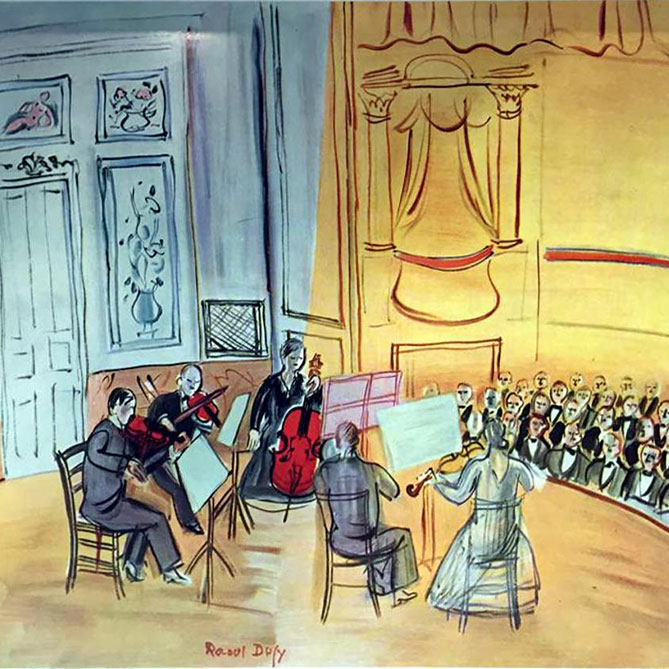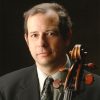
Great Chamber Music Reading and Watching
Thomas Rosenberg
Besides enormously enhancing listening skills, chamber music study also develops a players’ ability to sight-read, note read and watch. These are skills that are vital in orchestral situations as well. However, this is not about that kind of reading and watching! This is about books, movies and videos that will also greatly enhance the skills of anyone playing chamber music.
READING: There are some great books out there about chamber music. None of these are long (300 pages or less) and are relatively quick and easy reading. I hope this will spur the interest of those reading this article to check some of them out.
Con Brio: Four Russians Called The Budapest String Quartet by Nat Brandt
The Budapest Quartet was perhaps the greatest quartet ever…or certainly one of the most important. They existed for nearly 50 years, and their influence lasted far beyond their last concert in 1967. In particular, their legendary second violinist, Sasha Schneider coached many of the players in the next several generations of great quartets…including many who are still active today. The book is a fascinating look into the history of the quartet, the dynamics between its members, and many stories of their travels as what was really the first full-time professional string quartet. Their career paved the way for the many that followed. Nat Brant, son-in- law to the quartet’s violist Boris Kroyt, who played in the quartet for thirty years, writes the book with personal insight.
Indivisible by Four—A String Quartet in Pursuit of Harmony by Arnold Steinhardt.
This is a beautifully written book by the great first violinist of the Guarneri String Quartet. There are passages that accurately and beautifully describe the thought processes that occur during a performance, as well as many stories about the germination and growth of the amazing career of the Guarneri String Quartet. The quartet played together for 45 years, (from 1964-2009). The only personnel change occurred in 2001 when cellist David Sawyer was no longer able to maintain the touring schedule of the group. Its early years were strongly influenced by members of the Budapest Quartet, and in many ways, their career took off where the Budapest Quartet’s career ended. This is a wonderful book from any perspective….from the most knowledgeable professional chamber musicians to those who know next to nothing about music.
Stormy Applause—Making Music in a Workers State by Rostislav Dubinsky
This fascinating book was written in 1989 by the amazing musician who was founding member and first violinist of the world-renowned Borodin Quartet that was formed in 1946 and existed for many years behind the “iron curtain” of communist Stalin-era and post-Stalin Soviet Union. Not only did the quartet have enormous political hurdles to overcome caused by official disapproval of their work, but also anti-Semitism. For those with memories of the Soviet Union, this book will be a reminder of those times. For younger readers, some of the stories may seem nearly unbelievable. Dubinsky immigrated to the USA in 1976 where he became head of the chamber music department at the Indiana University School of Music. In the words of the great American violinist Isaac Stern: “For anyone interested in the societal development in the Soviet Union in the years before Gorbachev, this book once begun will not be put down, even at the cost of sleep. Well written and colloquial, it evokes the core of the life of the Soviet musician from the death of Stalin to the time of Mr. Dubinsky’s departure from the Soviet Union. Every page has an authentic sound and smell to it. The author is extraordinarily sensitive both to the forces governing his political life and to the historical power of musical inquiry that drives a thinking musician. One reads, cries a little, sometimes giggles, and learns.”
The Art of Quartet Playing: The Guarneri String Quartet by David Blum
This is another book about the Guarneri Quartet, written 1986. The author was a well-known musician, writer, musicologist and personal friend of the members of the quartet. It is full of stories of the quartet’s history, the individual backgrounds of the members, and their individual ideas on many subjects including teaching, music making and creativity. There also is a detailed discussion of the major aspects of the quartet repertoire and some especially interesting discourse on Beethoven’s amazing Opus 131 String Quartet in C-sharp minor. This wonderful book is a little bit more scholarly and “hard-core” than some of the others, and especially interesting for those who know the repertoire or want to learn more about it.
Violin Dreams by Arnold Steinhardt
Arnold Steinhardt’s second book is not specifically about chamber music, but fits in because it is by one of the greatest chamber musicians of all time. It is such a great book about the journey of becoming a musician that I think EVERY STUDENT of any instrument, (and probably their teachers!) should read it. It is expressive, personal, and just plain interesting. His descriptive writing about the Chaconne from the D minor Partita by J.S. Bach is amazing. One very unique feature of this book is that it comes with a CD that has his performance of that Partita he made forty years ago, along with one he made in 2008 specifically for this book. In my opinion, a must read!!
Guide to Chamber Music by Melvin Berger
This is not a book that one reads for pleasure, but is instead a very valuable resource that contains information on most of the chamber music repertoire for strings or strings with piano. Presented in alphabetical order by composer, each chapter begins with biographical information. Works by that composer are then listed in chronological order, with movement titles and descriptive writing that amounts to brief program notes.
WATCHING: Here is some info on great chamber music watching. With the growth of YouTube, there is an amazing amount of material to explore. Many great historic quartet performances are posted on YouTube. However, many are not actually videos, but instead historic audio recordings, often accompanied by historic photographs. Although those are a great resource, they do not compare with actually seeing video of great chamber music performances. Many of that type of video are by young, “up and coming” ensembles. But there are videos of great performances by historically great chamber ensembles that are no longer on the concert touring circuit. .
There are also some documentary films about great quartets, and even some fictional movies about chamber music.
In The Mainstream: The Cleveland Quartet (available on DVD, and also on YouTube)
This is a documentary about the Cleveland String Quartet, one of the greatest quartets for about 20 years in the 1970’s and 80’s. The members have all gone on to very distinguished teaching careers. The film documents about a year of their traveling and performing around the globe in the early 1980’s. The film culminates at the Aspen festival in Colorado with a performance of the Mendelssohn Octet. Close observation of that part of the movie will yield several glimpses of this author both playing in the Octet and at a party scene at Aspen!
High Fidelity: Adventures of the Guarneri String Quartet (Available on DVD)
Not to be confused with a movie called “High Fidelity” starring Jack Black and John Cusack, this is a documentary of the legendary Guarneri String Quartet made in 1988 with performances of Mozart, Beethoven and others. It also has fascinating footage of their rehearsals, travelling and interpersonal dynamics.
A Late Quartet
This is a recent Hollywood film that in all honestly, I can NOT recommend. The story is ridiculous, convoluted, and not realistic. Many string players find the fake playing by the actors very hard to watch, though the actors certainly must have tried very hard to look like they knew what they are doing. Just the same, there are issues explored that do actually occur in professional quartets, and the music is beautifully played by the Borremeo Quartet. The most redeeming thing about this film is that it might actually inspire people to get to know the late quartets of Beethoven (Opus 127, 130, 131, 132, and 135). These are truly unique, transcendental and complex works of art, known by too few. They were the only major works Beethoven wrote after the Ninth Symphony, and are considered by many the greatest music ever written. These pieces are the reason many musicians want to become quartet players.
Here some interesting YouTube videos.
Schubert String Quartet No 14 D minor Death and the Maiden Alban Berg Quartet – YouTube
https://www.youtube.com/watch?v=Jlzv1yUFo-A
This is one of the great European Quartets, not often seen or heard in Minnesota.
Schubert Piano Trio No 2 in E flat major D929 Andante – Beaux Arts Trio – YouTube
https://www.youtube.com/watch?v=hpheRiBsTvw
Any performance by this legendary piano trio is of interest.
Guarneri String Quartet Beethoven (vaimusic.com) – YouTube
https://www.youtube.com/watch?v=vaSAdCvzPgU
Guarneri playing Beethoven Opus 95 (“Serioso”)
Brahms Klavierquartett nr 1 op 25 Mikhail Rudy, Guarneri Quartet.avi – YouTube
https://youtu.be/hDLwT-SO1gQ
The Guarneri again, with pianist Mikhail Rudy in a great performance. Of particular interest is that John Daly (usually 2 nd violin) is playing instead of Arnold Steinhardt. It shows how great a player he was.
Schubert – Quartetto Italiano – Quartetto in re min. D.810 – La morte e la fanciulla – YouTube
https://www.youtube.com/watch?v=EpaVFkV1Rlw
Rare footage of one of the most musically interesting, unique and long-lived of the post-WWII European Quartets. Elisa Pegreffi, (2 nd violin) was a groundbreaking female performer and a huge charismatic force in what was at that time, a male dominated quartet world.
Subjects: Chamber Music
Tags: cellobello, CelloBlog, chamber music, thomas rosenberg
